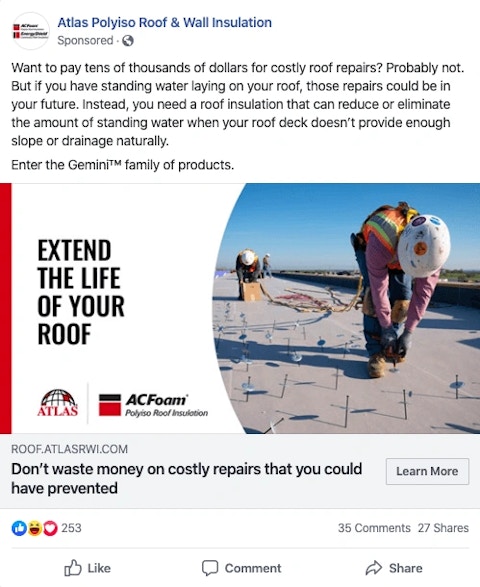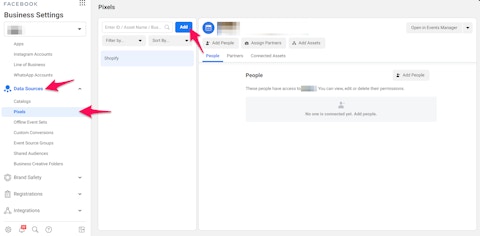Building materials manufacturers and distributors need to leverage online advertising in 2021 and beyond. Why? Because now, more than ever, building product audiences are relying on the internet to research products. Make purchases. Discover new brands. If your company doesn’t leverage online ads, you may miss out on conversions and fall behind competitors.
79% of marketers say pay-per-click ads (PPC) are hugely beneficial for their business. It allows them to increase their visibility to prospects who may have never heard of them otherwise. It’s an opportunity to communicate the value of building products and familiarize prospects with your business.
When we surveyed building product audiences with The Farnsworth Group, some fascinating trends came up; Amazon purchases increased from 8% to 12% in 2020. Online ordering from retailers increased from 23% to 40%. 33% tried a new product during the pandemic.
Channels like YouTube, Facebook and Instagram are becoming heavily relied on to learn more about products and make informed purchasing decisions. In fact, 48% of builders discovered new brands through online ads in 2020. It’s the perfect channel to directly communicate with your target audience in their times of need.
Let’s look at how building products manufacturers can begin targeting with online ads to drive conversions, revenue and increase brand awareness.
First things first. Let’s discuss the different types of ads that manufacturers and distributors can run and when they should be used.
Text Ads
Text ads are exactly what you think. They are simple, text-only advertisements with links to promote a company’s products and services. These are a good way to dip your toes into online advertising. They’re easy to launch and test. Plus, with text ads, you don’t have to worry about uploading multiple size aspects as they automatically change across all devices.
Running text ads is mostly reserved for pay-per-click advertising. A manufacturer pays every time one of their ads is clicked based on keywords they bid for. Google Ads is by far the leader in text ads but Bing is another platform to consider.
Below are three targeted advertising examples from Google search. These text ads seamlessly integrate with the organic results and are proven to increase brand awareness by 80% or more.

Use text ads to increase brand awareness by bidding on your brand name and appearing on the very top of Google search. Provide the latest promotions and sales to drive revenue. Offer free resources to drive users towards landing pages and generate leads.
Image Ads
Image ads are most popular with social media platforms like Facebook, Instagram and LinkedIn. Part of their appeal is that they blend into newsfeeds and don't interrupt the user experience. A visual catches the attention of prospects while a call to action drives them to a specific page on your website.

Manufacturers and distributors can include a single photo within an ad or create a carousel of two to ten images. Pictures should show the product in motion, show people that resemble the target audience or include bold sales copy.
Video Ads
According to Hubspot, 78% of video marketers report that video marketing has improved their company’s bottom line. Video ads offer an engaging way to reach prospects, educate them about products and get them into your building materials marketing funnel
Channels manufacturers can use to launch video ads include LinkedIn, YouTube and Facebook. Video allows you to cover a wide range of content that can be educational and informative using visual storytelling to demonstrate how your products work in real-life settings.
Show the installation of your products compared to competitors. Give customers a behind-the-scenes look of business operations. Introduce them to team members and create a deeper connection.
Running ads isn’t as simple as putting together creatives, sales copy and launching. Building products manufacturers must have accurate targeting to maximize conversions and return on ad spend. These are ways businesses can improve their targeting on major ad platforms.
Google Ads Targeting
Google Ads targeting is based on the keywords you bid for. When these phrases are searched on Google, your ad will appear. Use keywords that your customers use to discover products, information and content. Analyze surveys, testimonials, reviews and analytics to find patterns in their language or use Google’s in-house tool. Select “Discover new keywords” while on Keyword Planner’s dashboard.

Enter a keyword related to your company or advertisement and click “Get Results.”

Select phrases based on the individual campaign you plan to run. Copy these or click “Add keywords to create plan” after they’re chosen via the left checkbox.

Depending if your company chooses display, search or video ads, these are the available targeting options you’ll have at your disposal:
- Affinities such as passions and hobbies.
- Custom audiences based on habits, interest and purchase intent.
- Traditional demographics like age, income and location.
- Life events and milestones.
- In-market activity based on recent purchase intent.
- Remarketing after users have interacted with your business (more on that later).
- Reach existing customers with CRM data.
- Similar audiences based on your website visitors or existing customers.
Facebook and Instagram Targeting
Facebook not only allows you to set up specific geographical locations for your ads, but also lets you go to a granular level with interests, occupation, connections and education.
Most importantly, marketers have the option to create a custom audience. For example, import contacts from your CRM to target people you already have in your client database. This will increase the conversions and performance of Facebook Ads as you continue existing engagements with customers that know your company.
Begin by installing the Facebook Pixel to collect audience data from users who visit your website. Navigate to the Audiences section of Business Manager, click “Data Source” and “Pixels.”

Click “Add,” assign the pixel a name and enter your website URL to view which setup options are available.

Facebook Pixels can be added manually, through a partner integration or by emailing instruction to a developer. Once the Pixel is installed, Facebook will begin collecting audience data. Send ads to these individuals or use their information to create lookalike audiences.
LinkedIn Ads Targeting
LinkedIn gives you the unique opportunity to connect with industry professionals, decision-makers and reach them with timely ads using the various formats we’ve discussed so far.
Four out five LinkedIn members drive business decisions and have 2x the buying power of average web audiences. Building product manufacturers can leverage LinkedIn to place their products and content in front of an audience that is the most likely to convert and take action.
LinkedIn is ideal for targeting prospects based on job title, industry, education, organizations and the company they work for. Manufacturers and distributors may also market to known prospects by uploading CRM data and segment audiences to retarget based on previous behavior.
Visit LinkedIn’s ad platform and begin creating an audience based on company and position.

An estimate of the campaign’s audience size and ad spend is displayed on the right. The campaign manager will walk you through the remaining steps including objective, ad format and placement.
While online advertising has the potential to drive growth for building products manufacturers, you can’t stop there. What if a prospect doesn’t engage with your ad or convert? Not being able to continue communication and present offers to them will result in lost opportunities.
That’s where retargeting comes into the picture. This is the process of delivering ads to customers who’ve previously engaged with your business. Retargeting can lift ad engagement rates up to 400% by offering timely and relevant messaging to those familiar with your products.
Manufacturers and distributors can retarget those who’ve landed on specific pages, spent a certain amount of time on their website or purchased particular products. All major ad platforms, including the ones in this article, have built-in retargeting features to help you achieve this.
It’s also essential to perform A/B split tests. These are tests in which you take two creatives, ads or other elements and test them against each other. This helps your company discover the highest converting assets to invest more ad spend in. As a matter of fact, 60% of companies believe A/B split testing is highly valuable for conversion rate optimization.
We suggest regularly checking analytics for optimization opportunities and ensuring ads are on target to reach advertising goals. Key performance indicators (KPIs) to measure include:
- Impressions
- Clicks
- Ad spend
- Click-through rate
- Conversion rate
- Quality score
- Cost per conversion/acquisition
Final Thoughts on Targeting With Online Ads
The online landscape for building products manufacturers is changing rapidly. They must stay up to date on how to reach target audiences to continue driving growth and conversions. Online advertising is now an essential channel.
Platforms like Google, Facebook, Instagram and LinkedIn enable companies to reach more customers, create a direct connection with prospects and drive traffic back to key assets. Ads can be created in different formats such as text, video and photo. Each format has a different purpose and benefit.
Manufacturers and distributors must retarget builders and contractors who they’ve already interacted with to drive sales and increase return on ad spend. These include website visitors, previous customers, leads and other segments. Advertisements become highly personalized and relevant based on previous behavior.
Split test ads and creatives to find winning combinations of sales copy, images and audiences. Continually check analytics to ensure that you’re reaching advertising goals and no issues are occurring with ad accounts.
Do you want to establish and build relationships with the A&D community to drive more growth for your company? Venveo can help you establish and grow an ecommerce presence as a building materials manufacturer through intuitive digital marketing services.








